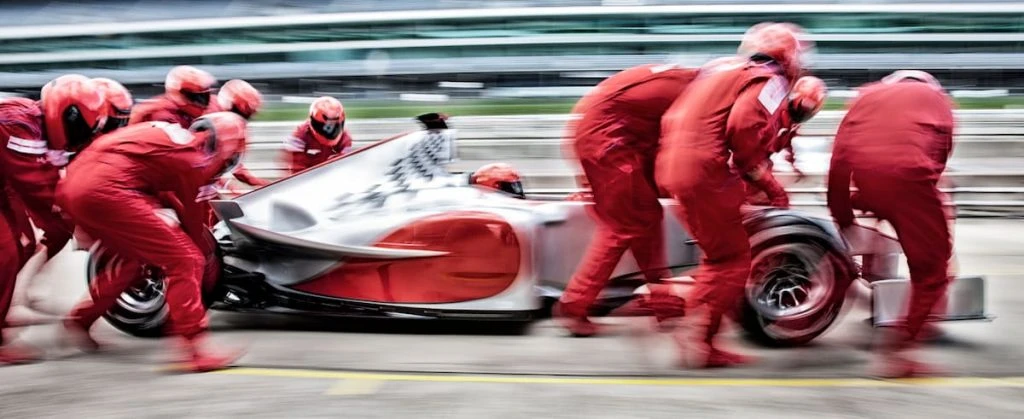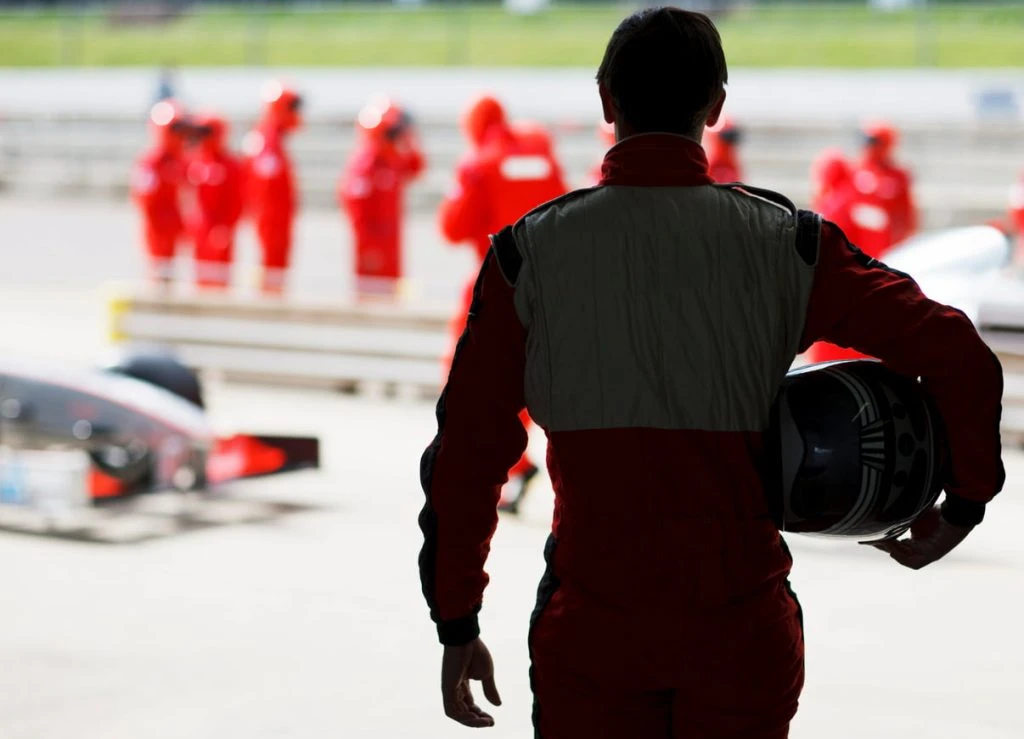How Fast Do Formula 1 Cars Go? | Fastest Recorded Speed
Formula 1 is often called the ‘Pinnacle of Motorsport’ for its teams developing the world’s most advanced racing cars. Wondering how fast these incredible machines go is, unsurprisingly, an oft-asked question and a go-to comparison with the other racing series that are also sports of speed.
There is no simple answer, as the sport regularly undergoes plenty of rule changes and design restrictions. In fact, the FIA, F1’s governing body, implemented changes to slow the cars down over the years, limiting how fast the F1 cars can go. You will find varying answers depending on the era and the regulations in place.
In modern-day Formula 1, the cars will regularly exceed 300 km/h at almost every track the sport visits. Circuits with long straights, like Italy’s Monza, will see the drivers hit higher top speeds, and Sebastian Vettel reached 362 km/h in 2021. The Italian circuit had Lewis Hamilton record the fastest F1 qualifying lap in history, clocking in a 1:18.887 time over the 5.793 km/3.6-mile course, to average 264.36 km/h on his lap or 164.267 mph.
Formula 1 Car Speed
Downforce heavily dictates the speed of a Formula 1 car, as the front and rear wings generate air friction to keep the vehicle stuck to the road. The downforce is essential for F1 cars to corner at the fastest possible speeds, but it slows them down on straights as the air resistance generates drag.
A rule in place since 2011 called the Drag Reduction System, often referred to by its acronym, DRS, lowers the rear wing’s downforce effectiveness and allows higher speeds. A moveable part of the rear wing opens when the driver uses DRS on a straight. This opening means the car can get closer to achieving its maximum potential speed.
Formula 1 cars can reach higher speeds when the teams set the front and rear wings at angles closer to horizontal than vertical. However, top speed is only important on a track’s straight, while grip and handling are factors to consider in corners. The fastest laps that take pole position or a race win will come from a team that can find the perfect balance between top speed and cornering grip at the many tracks F1 visits on its calendar.

F1 Cars Top and Average Speeds
An F1 car’s top speed refers to the maximum speed that the car can achieve at a specific part of the racetrack, typically at the end of a long straight and when using DRS. Drivers usually reach this speed in qualifying as they seek to set the fastest lap with low fuel and new tyres. That combination results in the car being the lightest it will be over a race weekend and having the grippiest tyres.
By comparison, the average speed of an F1 is calculated by dividing the total distance covered by the time taken to complete that distance. In the event of qualifying, that average speed refers to a single lap, while during a race, it means the total distance of all the laps a driver completes. Average speed takes into account the slower speeds that the car reaches as it navigates the numerous corners that require precision and control.
What Is The Top Speed of a Formula 1 Car?
The fastest speed an F1 car has reached is 397.3 km/h, or 246.9 mph, but this was with a modified version of the BAR-Honda team’s 2005 car, the BAR 007. Driver Alan van der Mewe drove the car on the Bonneville Salt Flats in Utah, USA, attempting to reach 400 hm/h.
The car did exceed its target on one run, but speed attempt rules dictate the recorded time must happen in two directions to negate wind speed. One way that BAR-Honda could reach such a high speed was by switching the draggy rear wing for a stabilization fin to help keep the car pointing forwards rather than generating downforce.
More conventional top speeds for Formula 1 come during a Grand Prix weekend when the race car drives in practice, qualifying, or the race itself. Race cars will reach the fastest speeds when driving in a straight line on a track. In the case of Valtteri Bottas racing for Williams in 2016 at the Baku Street Circuit in Azerbaijan, he hit 378 km/h or 234 mph on the track’s 2.2 km main straight.
The official FIA speed traps only logged 366.1 km/h. However, the Williams team later confirmed their data had the extra 12 km/h as Bottas kept accelerating, past the speed trap helped by the long straight, DRS, and a slipstream from Red Bull Racing rival Max Verstappen ahead of his car.
What Are The Average Speeds of F1 Cars?
The American oval racing series NASCAR measures lap times and the average speed at that a driver completes a lap of an oval circuit. By comparison, F1 is all about lap times, and the maximum or average speeds involved in completing the lap do not factor into most coverage.
In both sports, you can deduce the average speed by dividing the circuit length by the time a driver completes the lap, with faster lap times generating higher average speeds. However, with the wide variety of circuits that F1 visits, the average speed of a lap will vary over the season.
A tight and twisty type of circuit, such as at the world-famous Monaco Grand Prix, will have lower average speeds than a higher-speed race like the British Grand Prix. The average speed in Monaco is around 150-160 km/h or 93-99 mph. At Silverstone for the British Grand Prix, expect to see a 250 km/h or 150 mph average speed.
How Fast Do F1 Cars Get to 100 mph?
F1 cars reach 100 mph from 0 mph in under 4 seconds, with the 2016 Mercedes W07 launching to 124 mph (200 km/h) in just 4.2 seconds. Although an F1 car does reach 100 mph faster compared to standard road cars, or even hypercars, an F1 racing car isn’t set for drag racing, and most acceleration comes from slow speeds rather than a standing start.
F1 cars will only do a 0-100 mph run once in a standard Grand Prix at the race start. The only other times when the vehicles are stationary are when people work on the car at a pit stop or after a race stoppage requiring an additional race start. However, a pit lane has safety in mind rather than performance, and a speed limit prevents F1 cars from reaching excess speeds. As such, 0-100 mph is never possible after a pit stop for safety reasons.
How Fast Can a Formula 1 Car Go From 0 to 100 to 0?
The incredible stopping power of an F1 car’s brake discs and downforce combined make the cars come to a complete halt much faster than standard vehicles. Every F1 car can reach 100 mph from a standing start and return to 0 mph within 5 seconds.
How Fast Can a Formula 1 Car Go on a 90-degree Turn?
An F1 car’s most impressive ability is the speed at which it turns corners. The downforce of an F1 car with the racing abilities of the driver at the wheel allows a higher race speed than F1’s competition like NASCAR, Formula E, and Indycar. A 90-degree corner with a large radius, such as Monza’s Curva Grande, can see F1 cars cornering at 250 km/h or 155 mph. A tighter 90-degree corner, such as Sainte Devote, Monaco’s first turn, will see drivers tackling the right-hander at around 85 km/h or 52 mph.
Can F1 Cars Go 300 mph?
F1 cars can’t go 300 mph. The fastest official recorded speed of an F1 car is 246.9 mph when BAR Honda ran a modified version of the 2005 car on the Bonneville Salt Flats in Utah, USA. In a race, Valtteri Bottas reached a record-high speed at the 2016 Mexican Grand Prix. The Finnish driver set the speed record when his Mercedes hit 372.5 km/h or 231 mph.
💡 How Do Formula 1 Cars Compare to Other Racing Cars?
Formula 1 cars are the fastest cars in motorsports when taking straight and cornering speeds into account. Other series beat F1 in terms of fastest speeds, but because of the highly-advanced aerodynamics involved in Formula 1, no other championship sets quicker lap times.
Are Formula 1 Cars the Fastest?
F1 cars are not the fastest cars in the motorsport world. That accolade goes to America’s single-seater IndyCar series, where the cars can reach top speeds of around 380 km/h or 236 mph. However, these speeds come during Indycar’s visits to some of America’s largest oval race courses when the car’s setup is low downforce to reach the best speeds.
Are Formula 1 Cars Faster Than NASCAR? Or is NASCAR Faster than F1?
The weight of a NASCAR entry vs an F1 car means that F1 has a distinct advantage in any speed head-to-head. NASCAR has a minimum of 3,100 lb or 1,451 kg without any driver or weight, and their top speeds are approximately 200 mph or 321 km/h. By comparison, F1’s minimum weight in 2023 is 798kg or 1,760 lb, with top speeds around 231 mph or 372.5 km/h.
F1 vs IndyCar?
F1 and Indycar have a lot of comparisons as the two leading open-wheel single-seater racing championships. However, the tracks that the two championships visit differs: F1 switches between dedicated racing circuits and street tracks, while IndyCar races on these plus ovals.
As a result, IndyCar teams have to set up their cars dramatically differently for any sessions on an oval track, like the Indy 500 at the Indianapolis Motor Speedway. For this reason, Indycar sees higher top speeds than F1 has on the more traditional racing circuit.
However, in a like-for-like competition, such as at the Circuit of the Americas in Austin, Texas, F1 sets far quicker lap times. The only time Indycar raced here in 2019, the drivers took the chance to record their best lap times in qualifying, and Will Power set a 1:46.0177. By comparison, the Mercedes of Valtteri Bottas scored a 1:32.029 in F1’s qualifying that same year.

⚙️ F1 Car Engine Construction For Top Speed
Modern-day Formula 1 cars’ engines are some of the most advanced ever constructed. As the sport looks to become more sustainable, the teams have thrown everything at making them the most efficient engines on the planet to score the most points in a season.
Fans might see the likes of Charles Leclerc, Lando Norris, and Fernando Alonso looking to become the winner on the race track, but it’s Ferrari, Mercedes, Honda, and Renault battling behind the scenes to develop the best engine. These four manufacturers are responsible for providing the 10 teams with the components that allow F1 cars to drive so fast.
How Have Formula 1 Cars Evolved Over The Years?
The regulations and rules overseeing Formula 1 change regularly, and today’s cars are far more advanced and faster than their counterparts from decades ago. With higher speeds, both drivers and spectators would be at higher risk from crashes and flying debris in collisions, so the cars’ safety has also evolved alongside engine development.
What Are The Main Components of a Formula 1 Car?
Unlike the standard engines of old, a modern-day F1 car has a so-called ‘power unit’ comprising multiple components, including an engine. An internal combustion engine, motor generator unit (kinetic), motor generator unit (heat), battery/energy store, turbocharger, control electronics, and exhaust are the main components inside a Formula 1 car in 2025.
Combining these components is how Formula 1 cars can generate so much power, as they use far more than just an engine to race. The two motor generator units convert heat and kinetic energy lost under braking into electricity that a driver can deploy to gain extra horsepower. By transferring otherwise lost kinetic and heat energy into the energy store, an F1 car can accelerate much faster than solely relying on an engine.
How Does Aerodynamics Play into Formula 1 Car Design?
Aerodynamics plays a significant role in F1 today, but the first F1 cars had no downforce-generating parts. It wasn’t until the late 1960s that aerodynamics first appeared, and the changes over the years have been dramatic. After a rule change in 2022, today’s teams can also utilize the air flowing underneath the cars to create what is known as ‘ground effect aero,’ effectively sucking the cars to the ground and allowing them to corner even faster.
Who Designs Formula 1 Cars – How are Formula 1 Cars Designed?
While drivers like Fernando Alonso, Kimi Raikkonen, and Rubens Barrichello have the most experience driving F1 cars, many an engineer in the F1 world can claim an even longer career than these racers. The longest-serving car designers, such as Red Bull’s Adrian Newey, joined F1 in the 80s and 90s and have designed dozens of cars over decades in the sport.
These engineers must design an F1 car to the strict rules that the FIA, F1’s governing body, dictates for each season. The teams will review the information in the rule book page by page to try and gain any advantage over the others at rival teams doing the same job.
How Do Teams Design and Build a Formula 1 Car?
Although the four engine manufacturers, Ferrari, Mercedes, Honda, and Renault, design and develop the power units in F1, there are 10 teams that develop the cars. A team’s engineers will look at how best to fit a power unit in their car and use the FIA regulations for an upcoming season in their design plans.
Each team uses CAD software to virtually simulate their designs before building components that they connect together at their own factory or headquarters. A Formula 1 car will go through multiple design iterations before its eventual debut on track as the team seeks to assess every factor to make the best car when it finally sees some action.
🏁 F1 Car Speed and Driver Skills
Formula 1 cars are incredibly advanced, so the drivers in the cockpit must also be the best in the world to control these powerful machines under the pressure of an international audience. As any other athlete does, F1 drivers train in the gym, but they must pay particular attention to training their neck muscles. A thing called g-force, the equivalent forces of gravity that fighter pilots must endure, heavily impacts F1 drivers when cornering and is one of the main challenges in racing at high speeds.
Formula 1 drivers use all their various experiences of driving karts as kids and single-seater cars as teenagers to control an F1 car when racing. However, the driver must also work with their team to manage tire wear during a race as an extra skill. The tires are the only part of the car that makes contact with the race track, so driving smoothly to reduce their wear is vital to maintain high speeds during a race.
🏆 Formula 1 Car Speed Records
Although Formula One is a sport with the simple goal of being the fastest driver on a day to be at the top of the order, there is much more to F1 than setting the fastest speeds. If you take the opportunity to watch F1 video content on YouTube or Instagram, you will find examples of F1 cars racing unbelievably fast. Some of the most noteworthy F1 speed records are:
- Highest average race speed: Michael Schumacher (153.843 mph or 247.586 km/h) in the 2003 Italian Grand Prix
- Highest average qualifying lap speed: Lewis Hamilton (164.267 mph or 264.362 km/h) in the 2020 Italian Grand Prix
- Highest average race lap speed: Rubens Barrichello (159.892 mph or 257.321 km/h) in the 2004 Italian Grand Prix
- Highest top speed: Valtteri Bottas (234.878 mph or 378 km/h) in the 2016 European Grand Prix
- Highest race top speed: Valtteri Bottas (231.461 mph or 372.5 km/h) in the 2016 Mexican Grand Prix
❓ FAQs About How Fast Formula 1 Cars Go
Formula One cars are some of the fastest vehicles that race in any motorsport anywhere in the world, so it’s no surprise that so many people ask how fast F1 cars can go.
How fast do Formula 1 cars go?
F1 cars excel at driving fast around corners better than any other cars. Valtteri Bottas recorded F1’s fastest speed at the Baku Street Circuit in 2016, reaching 234 mph on the track’s 2.2 km main straight.
How fast do F1 cars go in KM?
Valtteri Bottas’ fastest recorded speed of 234 mph over the 2016 European Grand Prix weekend. That speed equates to 378 km/h.
Can F1 cars go 300 mph?
No, F1 cars cannot go 300 mph, but the speed record for an F1 car is 246.9 mph when a modified 2005 BAR Honda raced on the Bonneville Salt Flats.
How does aerodynamics play into Formula 1 car speeds?
Aerodynamics helps a Formula 1 car generate downforce, allowing an F1 car to corner much faster than any car designed without aerodynamics in mind.
How do drivers control a Formula 1 car?
F1 drivers spend their entire lives driving, from karts as a child to less powerful single-seater cars as a teenager, before reaching F1 and spending countless hours in F1 cars and world-leading F1 simulators. Their skill, plus the talented engineers that design the cars, allow them to control F1 cars.
How much faster could F1 cars go if there were no design restrictions?
Regulations restrict how fast F1 cars can go, but the legendary F1 engineer Adrian Newey designed the Red Bull X2010 as a concept F1 car without any design restrictions. When used in a simulator, the car would reach 292 mph, or 310 mph, if slipstreaming another car.
📚 Find More Guides About the Most Popular Formula 1 Topics






Jim is a freelance motorsport journalist, editor, and podcaster. He’s a content creator specializing in motorsport with 11+ years of experience across technical and creative positions. Jim has an impressive track record of writing race reviews and opinion pieces for Formula One. He’s particularly proud of interviewing personalities from the motorsport industry.









